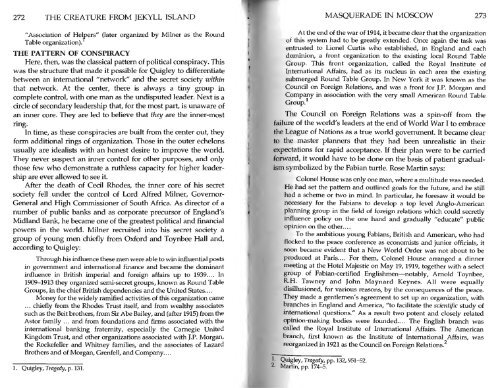Create successful ePaper yourself
Turn your PDF publications into a flip-book with our unique Google optimized e-Paper software.
272 THE CREATURE FROM JEKYLL ISLAND MASQUERADE IN MOSCOW 273<br />
"Association of Helpers" (later<br />
organized by MiLner as the Round<br />
Table organization).<br />
THE PATTERN OF CONSPIRACY<br />
Here, then, was the classical pattern of political conspiracy. This<br />
was the structure that made it possible for Quigley to differentiate<br />
between an international "network" and the secret society within<br />
that network. At the center, there is always a tiny group in<br />
complete control, with one man as the undisputed leader. Next is a<br />
circle of secondary leadership that, for the most part, is unaware of<br />
an inner core. They are led to believe that they are the inner-most<br />
ring.<br />
In time, as these conspiracies are built from the center out, they<br />
form additional rings of organization. Those in the outer echelons<br />
usually are idealists with an honest desire to improve the world.<br />
They never suspect an inner control for other purposes, and only<br />
At the end of the war of 1914, it became clear that the organization<br />
of this system had to be greatly extended. Once again the task was<br />
entrusted to Lionel Curtis who established, in England and each<br />
dominion, a front organization to the existing local Round Table<br />
Group. This front organization, called the Royal Institute of<br />
International Affairs, had as its nucleus in each area the existing<br />
submerged Round Table Group. In New York it was known as the<br />
Council on Foreign Relations, and was a front for J.P.<br />
Morgan and<br />
Company in association with the very small American Round Table<br />
Group.<br />
failure of the world's leaders at the end of World War I to embrace<br />
the League of Nations as a true world government. It became clear<br />
to the master planners that they had been unrealistic in their<br />
expectations for rapid acceptance. If their plan were to be carried<br />
forward, it would have to be done on the basis of patient gradualism<br />
symbolized by the Fabian turtle. Rose Martin says:<br />
those few who demonstrate a ruthless capacity for higher leadership<br />
are ever allowed to see it.<br />
After the death of Cecil<br />
Rhodes, the inner core of his secret<br />
society fell under the control of Lord Alfred Milner, Governor-<br />
General and High Commissioner of South Africa. As director of a<br />
number of public banks and as corporate precursor of England's<br />
Midland Bank, he became one of the greatest political and financial<br />
powers in the world. Milner recruited into his secret society a<br />
group of young men chiefly from Oxford and Toynbee Hall and,<br />
according to Quigley:<br />
Through his influence these men were able to win influential posts<br />
in government and international finance and became the dominant<br />
influence in British imperial and foreign affairs up to 1939.... In<br />
1909-1913 they organized semi-secret groups, known as Round Table<br />
Groups, in the chief British dependencies and the United States....<br />
Money for the widely ramified activities of this organization came<br />
. . . chiefly from the Rhodes Trust itself, and from wealthy associates<br />
such as the Beit brothers, from Sir Abe Bailey, and (after 1915) from the<br />
Astor family ... and from foundations and firms associated with the<br />
international banking fraternity, especially the Carnegie United<br />
Kingdom Trust, and other organizations associated with J.P. Morgan,<br />
the Rockefeller and Whitney families, and the associates of Lazard<br />
Brothers and of Morgan, Grenfell, and Company. . .<br />
Colonel House was only one man, where a multitude was needed.<br />
He had set the pattern and outlined goals for the future, and he still<br />
had a scheme or two in mind. In particular, he foresaw it would be<br />
necessary for the Fabians to develop a top level Anglo-American<br />
, planning group in the field of foreign relations which could secretly<br />
1 . Quigley, Tragedy, p. 131<br />
2 - Martin, pp. 174-5.<br />
! Quigley, Tragedy, pp. 132, 951-52.<br />
influence policy on the one hand and gradually "educate" public<br />
opinion on the other.. .<br />
To the ambitious young Fabians, British and American, who had<br />
flocked to the peace conference as economists and junior officials, it<br />
soon became evident that a New World Order was not about to be<br />
produced at Paris.... For them, Colonel House arranged a dinner<br />
meeting at the Hotel Majestic on May 19, 1919, together with a select<br />
group of Fabian-certified Englishmen—notably, Arnold Toynbee,<br />
R.H. Tawney and John Maynard Keynes. All were equally<br />
disillusioned, for various reasons, by the consequences of the peace.<br />
They made a gentlemen's agreement to set up an organization, with<br />
branches in England and America, "to facilitate the scientific study of<br />
international questions." As a result two potent and closely related<br />
opinion-making bodies were founded.... The English branch was<br />
called the Royal Institute of International Affairs. The American<br />
branch, first known as the Institute of International Affairs, was<br />
reorganized in 1921 as the Council on Foreign Relations. 2


